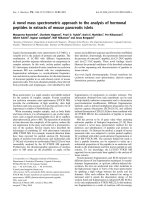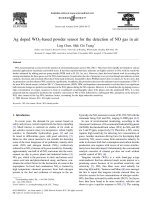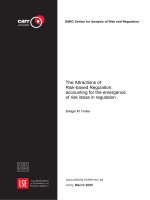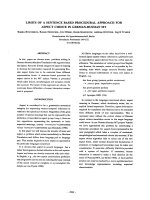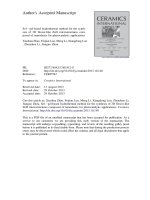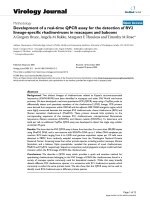A cluster based hierarchical approach for the recognition of bengali handwritten character
Bạn đang xem bản rút gọn của tài liệu. Xem và tải ngay bản đầy đủ của tài liệu tại đây (765.86 KB, 6 trang )
ISSN:2249-5789
Satarupa Bagchi Biswas et al , International Journal of Computer Science & Communication Networks,Vol 2(5), 590-595
A Cluster Based Hierarchical approach for the recognition of
Bengali Handwritten Character
Satarupa Bagchi Biswas1 , Smritikona Barai2, Sandipan Dutta3
1 .Asst. Professor, Dept. of IT, Heritage Institute of Technology, Kolkata.
2 .Asst. Professor, Dept. of IT, Heritage Institute of Technology, Kolkata.
3. .Asst. Professor, Dept. of IT, Heritage Institute of Technology, Kolkata..
Abstract
This work proposes a cluster based hierarchical
technique for recognition of handwritten Bengali
character. Due to the consecutive appearance of
Bengali text segmentation of Bengali character is
not very easy. For successful recognition of
handwritten Bengali character proper segmentation
is an important criterion. In this respect the present
approach trying to provide a complete solution for
Bengali handwritten character recognition. Here
mainly we will concentrate on single Bengali
character recognition.
Keywords:
Bengali Handwritten character
recognition, Clustering, OCR, Segmentation.
1. Introduction
Bengali is the second most used language in India.
Moreover certain languages like Manipuri, Ahamia have
the similar script like Bengali and also Bengali is the
official language of Bangladesh. Successful recognition
helps to office automation and saves huge amount of time
and effort. Though there are lots of commercially available
system is there but yet they can be further extended to
handwritten text. Thus handwritten character recognition
research for Bengali script has a lot of significance.
Research works on optical character recognition (OCR) for
printed Indian scripts including Bengali [1] are found in
the literature. A survey of Indian script character
recognition research is also available in [2]. However there
are not very significant research works done so far.
Unfortunately the technology used for printed character
cannot be extended for handwritten character recognition
Due to the numerous style of writing and complex nature
of Bengali character recognition of Bengali character is
really a challenging one. No generalized rules can be
formed to recognize character. The number of characters in
basic Bangla alphabet is 50 which is much larger than that
of Roman alphabet. Many algorithms/schemes for
handwritten character recognition [3,4] exist and each of
these has its own merits and demerits.The most important
aspect of a handwriting recognition scheme is the selection
of an appropriate feature set which is independent with
respect to shape variations caused by various writing
styles. A large number of feature extraction methods are
available in the literature [5].
Several approach like stroke based, chain code based
approach has already developed for successful recognition
of handwritten Bengali character. But as handwriting
varies from person to person so in our work we proposes a
scheme which is fully dependent on rules of Bengali
character writing.
2. Basics of Bengali Character Set
The Bengali script evolved from the Siddham, which
belongs to the Brahmic family of scripts, along with the
Devanagari and other written systems of the Indian
subcontinent. Among 50 characters 11 are considered as
vowel (Sarabarna) and rest are considered as consonant
(Byanjanbarna).The script starts from left to right and
there is no concept of capital or small letters like English
character set. The Bengali character set is depicted below:
590
ISSN:2249-5789
Satarupa Bagchi Biswas et al , International Journal of Computer Science & Communication Networks,Vol 2(5), 590-595
3.1 Pre-processing:
The pre-processing includes binarization of the sample,
thinning the sample, white space removal and extended
headline removal.
3.1.1 Binarization:
Figure 1: Bengali Character Set
2.1 Data Collection:
Writing style varies from person to person. In most of the
previous work the data was collected in laboratory. Here
we circulated a specially designed form (figure 2) among
25 persons to collect the samples of different writing
styles. In the above specified form, 50 separate boxes are
provided to enter one character at a time. Each box is
divided into three rows; the topmost is dedicated for the
curved line above headline (called ‘Matra’), the middle
row is for writing the body of the character, and the bottom
row is reserved for the dot (called ‘Bindu’) that some
characters contain. Some examples are given below:
Figure 2: Data Collection Form
These sample forms are scanned and thus the sample
data set is prepared. Now, from the whole character set,
five
characters
(one
vowel
and
four
consonants , , , ) are not considered for recognition,
as it has been observed that, either they are not used
independently, or their frequency of use is negligible in
Bengali language.
3. Recognition Methodology:
To recognize handwritten Bengali character, the
‘sample’ (here sample refers to the scanned handwritten
character to be recognized) needs to be pre-processed
before applying segmentation.
The first step of pre-processing is to convert the image
into a bi-tonal image. A bi-tonal image only contains two
tones or colors, white and black. If a pixel is black, then it
is considered to be a part of the sample, and if it is white,
then it is a part of the background.
The following images show the output of this step:
Before
After
Figure 3: The effect of Binarization.
3.1.2 Thinning:
The next step of pre-processing is to apply ‘thinning’ to
the bi-tonal sample which gives the ‘skeletal
representation’. The algorithm, we implemented for this
purpose, iteratively deletes pixels inside the shape to shrink
it without shortening it or breaking it into parts considering
8 neighbouring pixels in the 3 by 3 neighbourhood. It has
the following steps:
For each black pixel
Step1: Find out the number of black neighbour pixels.
Step2: Find out number of transitions from black to
white (or white to black) in the neighbourhood.
Step3: The subjected pixel is marked if any of the
following cases is true
Case1: all neighbours are black.
Case2: all neighbours are black except one.
Case3: all neighbours are white.
Case4: all neighbours are white except one.
Case5: number of transitions from black to white
(or white to black) is less than or equal to one.
Step4: Convert all marked pixels to white.
The following images show the output of this algorithm:
Before
After
Figure 4: The effect of Thinning.
591
ISSN:2249-5789
Satarupa Bagchi Biswas et al , International Journal of Computer Science & Communication Networks,Vol 2(5), 590-595
3.1.3 White Space Removal & Extended
Headline Reduction:
The sample may contain unnecessary white space
around itself. So, the next step is to remove these extra
white pixels to improvise the relative study of samples for
better recognition.
In addition to this white space removal, this process also
reduces the extended headline of the sample (if required).
The following images are showing how this step worked
on the sample.
Step1.1.1: The sample contains a curve at the lower
half. If yes, it is identified as the Bengali vowel
(aa),
else go to Step 1.1.1.1
Step1.1.2: The sample contains a curved line above the
headline. If yes, go to Step 1.1.2.1, else go to Step 1.1.2.2.
Step1.2.1: The sample contains a closed loop. If yes, go
to Step 1.2.1.1, else it is identified as the Bengali vowel
(u).
Step1.2.2: The sample contains a curve at the lower
half. If yes, go to Step 1.2.2.1, else go to Step 1.2.2.2.
Before
After
Figure 5: The effect of White Space Removal.
Step1.1.1.1: The sample contains a curved line above
the headline. If yes, it is identified as the Bengali vowel
(rhi), else it is identified as the Bengali consonant (jha).
Step1.1.2.1: The sample contains no black pixel to the
right hand side of its spine. If yes, it is identified as the
Bengali consonant
(dha), else go to Step 1.1.2.1.1.
Step1.1.2.2: The sample contains maximum number of
black pixels to the left hand side of its spine. If yes, go to
Step 1.1.2.2.1, else go to Step 1.1.2.2.2.
Before
After
Figure 6: The effect of Extended Headline Reduction.
3.2 Preparation of Hierarchical Clusters
based on Segmentation:
In this step, standard recognized Bengali character
samples are segmented to extract unique characteristics
(features). Based on these features, test samples can be
categorized into their respective clusters in a hierarchical
manner, such that, every leaf node of the hierarchy will
contain one unique character cluster. The algorithm
defined to categories the test samples into their respective
clusters using the extracted features is as follows:
Step1: The sample contains vertical line covering at
least 75% of its height (Say it is called the spine of the
sample). If yes, go to Step 1.1, else go to Step 1.2.
Step1.1: The sample contains two vertical parallel
lines, each covering at least 75% of its height. If yes, go to
Step 1.1.1, else go to Step 1.1.2.
Step1.2: The sample contains a curved line above the
headline. If yes, go to Step 1.2.1, else go to Step 1.2.2.
Step1.2.1.1: The sample contains a curve at the lower
half. If yes, go to Step 1.2.1.1.1, else go to Step 1.2.1.1.2.
Step1.2.2.1: The sample contains a loop. If yes, go to
Step 1.2.2.1.1, else go to Step 1.2.2.1.2.
Step1.2.2.2: The sample contains a loop. If yes, go to
Step 1.2.2.2.1, else it is identified as the Bengali consonant
(da).
Step1.1.2.1.1: The sample contains a loop on the right
hand side of the spine. If yes, it is identified as the Bengali
consonant (tta), else it is identified as the Bengali vowel
(oi).
Step1.1.2.2.1: The sample contains more black pixels at
the lower half. If yes, it is go to Step 1.1.2.2.1.1, else go to
Step 1.1.2.2.1.2.
Step1.1.2.2.2: The sample contains black pixels on the
left hand side of its spine. If yes, it is go to Step 1.1.2.2.2.1,
else go to Step 1.1.2.2.2.2.
Step1.2.1.1.1: The sample contains no headline. If yes,
it is identified as the Bengali vowel (ou), else it is
identified as the Bengali consonant (ttha).
592
ISSN:2249-5789
Satarupa Bagchi Biswas et al , International Journal of Computer Science & Communication Networks,Vol 2(5), 590-595
Step1.2.1.1.2: The sample contains ( curve at right
hand side. If yes, it is identified as the Bengali vowel
(ii), else it is identified as the Bengali vowel (i).
Step1.2.2.1.1: The sample contains loop at its bottom
side. If yes, it is identified as the Bengali consonant
(ddra), else go to Step 1.2.2.1.1.1.
Step1.2.2.1.2: The sample contains more black pixels at
right hand side. If yes, it is identified as the Bengali
consonant
(ja), else it is identified as the Bengali
consonant (dda).
Step1.2.2.2.1: The sample contains a vertical straight
line covering less than 50% of its height. If yes, it is
identified as the Bengali consonant
(chha), else go to
Step 1.2.2.2.1.1.
Step1.1.2.2.1.2.2: The sample contains a curve at the
lower half. If yes, it is identified as the Bengali vowel
(a), else go to Step 1.1.2.2.1.2.2.1.
Step1.1.2.2.2.2.1: The sample contains only one loop. If
yes, it is identified as the Bengali consonant (ddha), else
it is identified as the Bengali consonant (dhra).
Step1.2.2.1.1.1.1: The sample contains two ) curves
horizontally. If yes, it is identified as the Bengali vowel
(o), else it is identified as the Bengali consonant
(ta).
Step1.2.2.2.1.1.1: Horizontal scan lines cross the
sample at two or less points. If yes, it is identified as the
Bengali consonant
(visargha), else go to Step
1.2.2.2.1.1.1.1.
Step1.1.2.2.1.1: The sample contains a ) curve in the
left half. If yes, it is identified as the Bengali consonant
(yya), else go to Step 1.1.2.2.1.1.1.
Step1.1.2.2.1.1.1.1: Horizontal scan lines cross the
sample at more than three points. If yes, it is identified as
the Bengali consonant
(la), else go to Step
1.1.2.2.1.1.1.1.1.
Step1.1.2.2.1.2: The sample contains less black pixels
at the lower half. If yes, it is go to Step 1.1.2.2.1.2.1, else
go to Step 1.1.2.2.1.2.2.
Step1.1.2.2.1.2.1.1: The sample contains one loop. If
yes, it is identified as the Bengali consonant
(pa), else
it is identified as the Bengali consonant
(sha).
Step1.1.2.2.2.1: The sample contains ( curve at left
hand side. If yes, it is identified as the Bengali consonant
(ka), else it is identified as the Bengali consonant
(pha).
Step1.1.2.2.1.2.2.1: The sample contains loop at left
half. If yes, it is go to Step 1.1.2.2.1.2.2.1.1, else go to Step
1.1.2.2.1.2.2.1.2.
Step1.1.2.2.2.2: Horizontal scan lines cross the sample
at two or less points. If yes, it is identified as the Bengali
consonant (cha), else go to Step 1.1.2.2.2.2.1.
If yes, it is identified as the Bengali consonant
ta), else it is identified as the Bengali consonant
Step1.2.2.1.1.1: The sample contains ( curve. If yes, it
is identified as the Bengali consonant
(bha), else go to
Step 1.2.2.1.1.1.1.
Step1.2.2.2.1.1: The sample contains negligible number
of black pixels at the bottom left corner. If yes, it is
identified as the Bengali consonant (anushwar), else go
to Step 1.2.2.2.1.1.1.
Step1.1.2.2.1.1.1: The sample contains a loop in the
upper half. If yes, it is identified as the Bengali vowel
(e), else go to Step 1.1.2.2.1.1.1.1.
Step1.1.2.2.1.2.1: The sample contains no loop. If yes,
it is identified as the Bengali consonant
(ga), else go to
Step 1.1.2.2.1.2.1.1.
Step1.2.2.2.1.1.1.1: The sample contains one loop only.
(khand(ha).
Step1.1.2.2.1.1.1.1.1: The sample contains one loop. If
yes, it is identified as the Bengali consonant
(na), else
it is identified as the Bengali consonant (ra).
Step1.1.2.2.1.2.2.1.1: The sample contains loop at top
half. If yes, it is go to Step 1.1.2.2.1.2.2.1.1.1, else it is
identified as the Bengali consonant
(ma).
Step1.1.2.2.1.2.2.1.2: The sample contains ( curve at
top left quadrant. If yes, it is go to Step 1.1.2.2.1.2.2.1.2.1,
else go to Step 1.1.2.2.1.2.2.1.2.2.
Step1.1.2.2.1.2.2.1.1.1: The sample contains ( curve at
left hand side. If yes, it is identified as the Bengali
consonant
(kha), else it is identified as the Bengali
consonant
(tha).
Step1.1.2.2.1.2.2.1.2.1: The sample contains ( curve at
bottom left quadrant. If yes, it is identified as the Bengali
consonant
(gha), else it is identified as the Bengali
consonant (sa).
593
ISSN:2249-5789
Satarupa Bagchi Biswas et al , International Journal of Computer Science & Communication Networks,Vol 2(5), 590-595
Step1.1.2.2.1.2.2.1.2.2: The sample contains ) curve at
left hand side. If yes, go to Step 1.1.2.2.1.2.2.1.2.2.1, else it
is identified as the Bengali consonant
(ba).
Step1.1.2.2.1.2.2.1.2.2.1: Vertical scan lines at the mid
crosses the sample at three points. If yes, it is identified as
the Bengali consonant (shha), else it is identified as the
Bengali consonant (yya).
Feature description
Spine
Curved line above the
headline
Closed loop
Present
in
sample?(Y/N)
N
Y
Next step to
follow
1.2
1.2.1
N
The sample is
identified as
the Bengali
vowel
4. Results & Discussion:
example-suppose
and
are the test samples to be
detected. After preprocessing, the detection algorithm is to
be applied on the processed samples. In the first case, the
detection algorithm will give the following resulting steps:
Feature description
Spine
Vertical line parallel to spine
Curved line above the headline
Maximum number of black
pixels to the left hand side of
the spine
More black pixels at the lower
half
Less black pixels at the lower
half
Less number of black pixels in
the top left corner
Loop at left half
Present
in
sample?(
Y/N)
Y
N
N
Y
Next step to
follow
1.1
1.1.2
1.1.2.2
1.1.2.2.1
N
1.1.2.2.1.2
N
1.1.2.2.1.2.2
N
1.1.2.2.1.2.2.1
N
1.1.2.2.1.2.2.1
.2
1.1.2.2.1.2.2.1
.2.2
1.1.2.2.1.2.2.1
.2.2.1
The sample is
identified as
the Bengali
consonant
(shha).
( curve at top left quadrant
N
) curve at left hand side
Y
Vertical scan line at the mid
has three crossections
Y
In the above described algorithm, several comparisons
of the number of black pixels present at different sides and
quadrants of a sample have been made. For this purpose,
certain threshold values for comparison have been
identified on a trial and error basis to achieve better results.
The accuracy of the algorithm has been measured for
each of the Bengali character classes and the mean of these
values can be treated as the overall accuracy of the
algorithm. The accuracy measured for some of the Bengali
characters are graphically depicted below:
Accuracy in Percentage
To test the effectiveness of the above Bengali
Handwritten character recognition procedure, handwritten
samples from each character class are fed to it. For
Whereas, in the second case, the detection algorithm will
give the following resulting steps:
(u).
Bengali
Handwritten Characters
Figure 7: Accuracy chart
and, the overall accuracy of the algorithm is
approximately 87.34%.
5. Conclusion:
In this paper we have presented a procedure to
recognize Bengali handwritten characters using
hierarchical clustering. Successful implementation of this
process will make it possible to translate Bengali
manuscripts into other languages, to convert manuscripts to
printable formats and many such applications. This
procedure can be further improvised to include the
recognition of whole Bengali handwritten words, sentences
and texts containing compound characters (called
‘Yuktakshar’), punctuation marks etc.
594
ISSN:2249-5789
Satarupa Bagchi Biswas et al , International Journal of Computer Science & Communication Networks,Vol 2(5), 590-595
6. References:
[1] Chaudhuri, B. B., Pal, U.: A Complete Printed Bangla
OCR System. Pattern Recognition, Vol. 31. (1998) 531549
[2] Pal, U., Chaudhuri, B. B.: Indian Script Character
Recognition: A Survey: Pattern Recognition, Vol. 37
(2004) 1887-1899.
[3] Plamondon, R., Srihari, S. N.: On-Line and Off-Line
Handwriting Recognition: AComprehensive Survey. IEEE
Trans. Patt. Anal. and Mach. Intell., Vol. 22 (2000)
63-84
[4] Arica, N., Yarman-Vural, F.: An Overview of
Character Recognition Focused on Off-line Handwriting.
IEEE Transactions on Systems, Man, and Cybernetics, Part
C: Applications and Reviews, Vol. 31 (2001) 216 - 233
[5] Trier, O. D., Jain, A. K. and Taxt, T.: Feature
Extraction Methods for Character Recognition - A Survey.
Pattern Recognition, Vol. 29 (1996) 641 – 662
595

